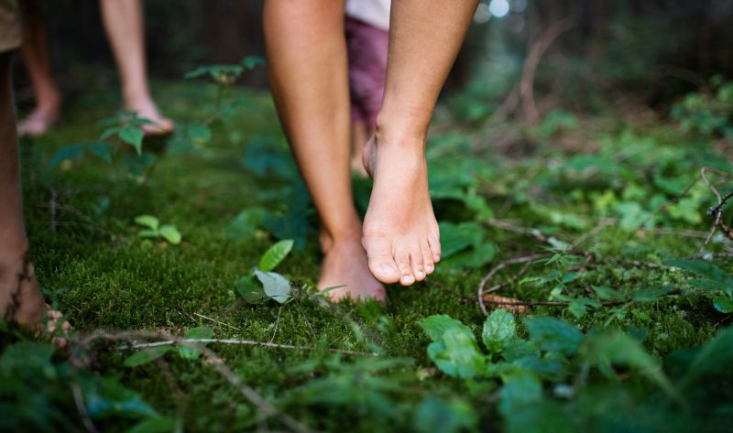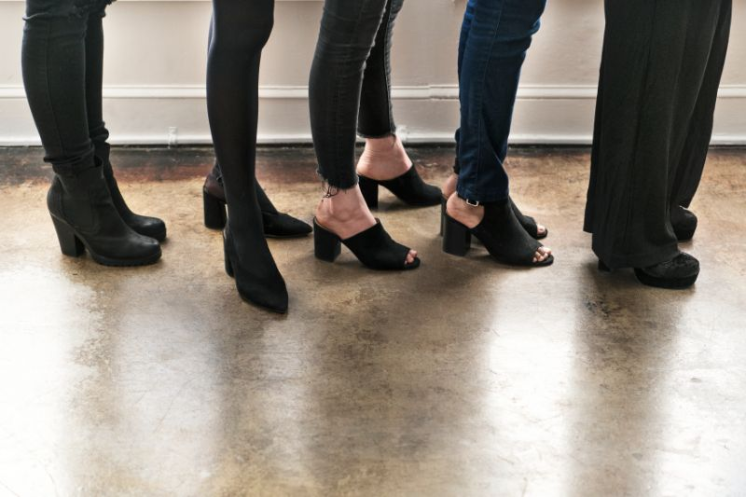Walking is a fundamental activity that we engage in every day. Whether we are strolling through a park or rushing to catch a bus, our feet are constantly in motion. But have you ever wondered about the historical background of walking barefoot versus wearing shoes? In this blog post, we will take a journey through time to explore the origins of walking barefoot, the evolution of footwear, and the impact both have had on our health and lifestyle.

Disclaimer: This article serves solely for informational purposes. It is imperative that you consult with your doctor before commencing any activities or practices described herein.
Origin of Walking Barefoot
Walking barefoot has been a cherished practice deeply rooted in human history since the earliest days of civilization. From the ancient times when our ancestors roamed the earth, unburdened by the constraints of footwear, they relied solely on the innate protection of their feet. The act of walking barefoot bestowed upon them a multitude of invaluable benefits that transcended mere convenience. It enhanced their balance, providing a heightened sense of proprioception and allowing them to navigate their surroundings with unparalleled precision. Moreover, the sensory feedback received through the soles of their feet awakened a profound connection to the earth, fostering a profound appreciation for the intricate textures and subtle nuances of the natural world. As each step was taken, the foot muscles were engaged, gradually strengthened, and meticulously honed, enabling our ancestors to traverse great distances with unwavering resilience. However, this ancient practice was not without its challenges. The absence of protective coverings rendered them susceptible to injury, particularly in treacherous terrains, while the discomfort experienced on rough surfaces served as a reminder of the delicate balance between vulnerability and resilience inherent in the human condition. Thus, walking barefoot stands as a testament to the intricate interplay between our primal instincts and the ever-present forces that shape our physical existence.
Evolution of Footwear

The invention of shoes marked a significant turning point in the history of walking. As civilizations evolved, so did the need for footwear. The designs and materials used in shoes have changed dramatically over time, adapting to the diverse landscapes and climates of different regions. From simple sandals made of plant fibers to intricately crafted leather shoes adorned with decorative elements, footwear has become more than just a practical necessity. It has evolved into a symbol of social status, cultural identity, and even personal style. The artistry and craftsmanship behind shoe-making have flourished, incorporating innovative technologies and creative designs that combine comfort, functionality, and aesthetic appeal. From athletic sneakers engineered to enhance performance to elegant high-heeled shoes that exude sophistication, the world of footwear continues to captivate and inspire.
Historical Cultures That Favored Barefoot Walking
Throughout history, numerous cultures across the globe have wholeheartedly embraced the practice of walking barefoot. In ancient times, both Egyptians and Greeks not only walked barefoot but also regarded it as a profound symbol of purity and a powerful means of establishing a deep connection with the earth. Similarly, Native American tribes and various African cultures also placed great value on barefoot walking, recognizing its inherent spiritual significance and its ability to ground oneself in the present moment. The act of walking barefoot, with each step directly touching the earth's surface, becomes an intimate and profound experience that transcends the boundaries of time and space, fostering a harmonious relationship between humans and the natural world.
Transition to Wearing Shoes
The transition to wearing shoes on a widespread scale can be attributed to various factors, including advancements in craftsmanship, protection against harsh environments, societal changes, and the evolution of fashion. As societies became more urbanized and interconnected, footwear gradually transformed from a mere practical necessity to a symbol of status and style. The development of new materials and techniques in shoemaking allowed for greater comfort, durability, and aesthetic appeal. Moreover, the growing awareness of foot health and hygiene also played a significant role in the adoption of shoes, as they provided essential protection against debris, diseases, and discomfort. Ultimately, the evolution of footwear reflects the intricate interplay between culture, technology, and human needs throughout history.
Impact of Footwear on Health and Lifestyle Historically
The adoption of footwear has had both positive and negative effects on foot health and overall lifestyle. On the positive side, shoes have not only provided protection from injuries but also offered support for individuals with specific foot conditions such as flat feet, high arches, and plantar fasciitis. Additionally, they have allowed people to comfortably engage in various activities, including sports and outdoor adventures.
However, it is important to acknowledge that the prolonged use of restrictive footwear can have negative consequences. For instance, wearing shoes that are too tight or narrow can lead to altered gait patterns, causing imbalances and muscle imprints. Moreover, certain types of footwear, particularly high heels, can contribute to foot deformities such as bunions and hammertoes.
Another aspect to consider is that wearing shoes for extended periods can reduce sensory input from the feet. The natural sensation of the ground beneath our feet provides valuable feedback to our body, helping us maintain balance and adapt our steps accordingly. By constantly relying on footwear, we may unintentionally dampen this sensory input, potentially affecting our body's proprioception and overall coordination.
In summary, while footwear has undoubtedly brought numerous benefits to foot health and lifestyle, it is crucial to strike a balance between protection and freedom. Understanding the potential drawbacks of prolonged use and choosing appropriate footwear that allows for natural movement and sensory feedback can help mitigate any negative effects on foot health and overall well-being.
Considerations for Walking Barefoot
While walking barefoot offers numerous benefits, such as improved balance, increased sensory feedback, and strengthening of the foot muscles, it is important to note that there are certain groups of people who should exercise caution and avoid going shoeless.
For instance, individuals with diabetes or peripheral neuropathy need to take extra precautions to protect their feet from potential injuries. Due to reduced sensation or impaired healing, even minor cuts or blisters can lead to serious complications. Therefore, it is recommended for them to wear appropriate footwear that provides additional protection and support.
Moreover, prolonged walking on hard concrete surfaces can cause discomfort, strain, and even the risk of stress fractures in the feet. This is especially true for individuals who engage in activities that involve repetitive impact, such as running or jumping. In such cases, wearing supportive footwear with cushioning and arch support becomes crucial to minimize the risk of foot-related issues.
By choosing the right footwear, individuals can ensure both comfort and foot health, reducing the likelihood of injuries and promoting overall well-being.
Choosing the Right Shoe Size
Choosing the right shoe size is as crucial as picking the appropriate type of footwear. An ill-fitting shoe can lead to discomfort, pain, and even severe foot problems over time. Here are a few tips to ensure a perfect fit:
- Measure Your Foot: Your shoe size can change over time, so it's a good idea to have your foot size measured every time you purchase new shoes. Most shoe stores can do this for you.
- Try Before You Buy: Try on shoes with the socks you plan to wear with them. Walk around the store to ensure comfort and a good fit.
- Check the Fit: There should be about a half-inch of space (or about the width of your finger) between your longest toe (which isn't always the big toe) and the end of the shoe.
- Width Matters: Shoes that are too narrow can cause blisters, calluses, and toe discomfort. The shoe should fit with enough room for your toes to move freely.
- Trust Your Comfort Level: No shoe should need a break-in period, they should be comfortable right away.
Remember, shoe sizes can vary between brands and styles, so always rely on what fits comfortably rather than sticking to a specific size. Discover the convenience of our complimentary shoe size converter, designed to assist you in finding the perfect fit.
Conclusion
The debate between walking barefoot and wearing shoes continues to intrigue us. As we explore the historical perspective of walking, it is important to strike a balance between the benefits and risks associated with both practices. Whether you choose to embrace barefoot walking, opt for supportive shoes, or find a middle ground with barefoot shoes, the key is to listen to your body and prioritize foot health. So, the next time you take a step, remember the rich history behind walking barefoot and the ongoing discussion that surrounds it.
Our Free Tools
Discover the power of our free tools and calculators to supercharge your health routine!

